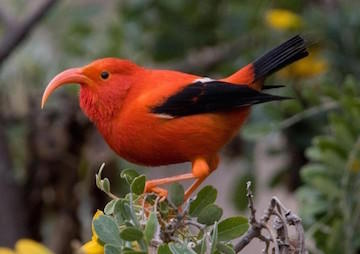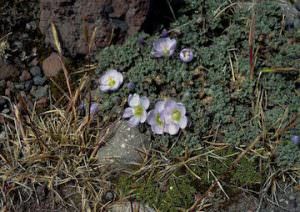Birds and Reptiles Are Feeling the Survival Heat
New scientific reports highlight yet again the threats that climate change and rising temperatures are posing for many species.
By Tim Radford, Climate News Network

The native ‘I’iwi (Vestiaria coccinea) is one of the Hawaiian forest birds threatened by climate-driven avian malaria spread. (Robby Kohley)
This Creative Commons-licensed piece first appeared at Climate News Network.
LONDON — The gloriously-coloured forest birds of Hawaii may lose at least half their living space because of climate change, according to new research.
And soaring global temperatures mean that many of the world’s lizards could be in trouble by 2100, and could seriously compromise the loggerhead turtle, whose sex is decided by the heat of the day at the time of incubation.
The plight of lizards is highlighted by Elvire Bestion, an ecologist at the University of Exeter Environment and Sustainability Institute, UK, and the Experimental Ecology Research Station at Moulis in France and colleagues in a report in the Public Library of Science journal PLOS Biology.
Greenhouse gases
They describe how they used a “Metatron” — a series of semi-natural enclosures in which temperatures could be turned up or down — to create two climates: one much like the present, the other 2°C warmer, the level at which the world’s nations wish to contain global warming by 2100, by limiting the combustion of fossil fuels that release greenhouse gases into the atmosphere.
In the course of two years, they tested 18 populations of the common European lizard (Zootaca vivipara), and observed each for one year to see what a temperature change did to growth rate, reproduction and survival.
Lizards are cold-blooded reptiles, and only active in the warmth of the sun, so they might be expected to benefit from an average rise in global temperatures. But, once again, researchers have found otherwise.
“Our findings indicate what may happen
if nothing is done to address
the primary drivers of decline.”
“It leads to faster growth of juvenile lizards and earlier access to reproduction,” Dr Bestion says. “It also leads to lower survival in adult individuals, which should endanger population survival.”
In fact, the prediction is that lizards at the southern end of their range will certainly feel the heat, and may have to leave life’s kitchen. Depending on how humans continue increasing carbon dioxide emissions and heating the atmosphere, this might threaten between 14% and 30% of Europe’s lizards.
Lizards are common and occupy a huge range, so there is no danger of wholesale extinction. There will be somewhere they can go, and northernmost species may even benefit.
The rarest birds of Hawaii’s forested mountains, on the other hand, are already at the limits of their range. And as the world warms, forest habitat is affected, and insect-borne pathogens gain in altitude, birds that already survive in dwindling numbers could disappear altogether.
Lucas Fortini, an ecologist with the US Geological Survey, and colleagues report in PLOS One that they looked into the future by matching sightings of the 20 rarest birds with climate projections and species distribution models. They report that 10 species may lose 50% of their range this century, and six of these may lose 90% of their range.
“As dire as these findings are, they do not mean that these bird species are doomed,” Dr Fortini says. “Instead, our findings indicate what may happen if nothing is done to address the primary drivers of decline: disease spreading uphill into the few remaining refuges.”

The size of loggerhead turtle hatchlings is checked on the Florida nesting beaches. (Florida Atlantic University)
Most of the North Atlantic’s loggerhead turtles (Caretta caretta) start their life in one place: the beaches of Florida. Although the turtles have been around for 60 million years, they could also be about to feel the heat, as the sex of a turtle is determined not by inheritance but by nest temperature during incubation.
Mother turtles dig holes in the sand, deposit around 100 eggs, and then retreat. Sand temperatures — affected by rainfall as well as depth — determine whether the babies become Arthur or Martha. Males emerge from cooler locations, females from warmer. But survival is precarious, and at most only one in 2,500 reaches adulthood.
Nest temperatures
Biological scientists Alexandra Lolavar and Jeanette Wyneken, of Florida Atlantic University, report in the Endangered Species Research journal that they monitored the species for four seasons and found that, for most of each season, nest temperatures were not sufficiently cool to produce males.
“If climatic changes continue to force the sex ratio bias of loggerheads to even greater extremes, we are going to lose the diversity of sea turtles, as well as their overall ability to reproduce effectively,” Professor Wyneken says.
“Sex ratios are already strongly female biased. That’s why it’s critical to understand how environmental factors — specifically temperature and rainfall — influence hatchling sex ratios.”
Tim Radford, a founding editor of Climate News Network, worked for The Guardian for 32 years, for most of that time as science editor. He has been covering climate change since 1988.
Your support matters…Independent journalism is under threat and overshadowed by heavily funded mainstream media.
You can help level the playing field. Become a member.
Your tax-deductible contribution keeps us digging beneath the headlines to give you thought-provoking, investigative reporting and analysis that unearths what's really happening- without compromise.
Give today to support our courageous, independent journalists.






You need to be a supporter to comment.
There are currently no responses to this article.
Be the first to respond.